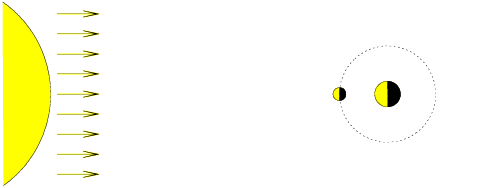 |
Summary of results:
Your score on this quiz is 80% (incorrect choices are highlighted in red).
#1. If you observe the Moon in the figure below, what phase will it have?
#2. If the Moon is located as shown in the figure below, where would it be located in the sky at 3am?
#3. If the waning gibbous Moon is rising on the eastern horizon, what time of the day or night is it?
#4. If the Moon is currently in the waning gibbous phase, what phase will it have in seventeen to eighteen days from now?
#5. If the waning crescent Moon rose nine hours ago, what time of the day or night is it?
Elapsed Time: 27 minutes
#1. If you observe the Moon in the figure below, what phase will it have?
| full | new |
| waning gibbous | waxing crescent |
| third quarter | first quarter |
| waning crescent | waxing gibbous |
 |
The Moon is located on the same side of the Earth as the Sun. It does not
appear illuminated from Earth, and thus is in the new phase.


#2. If the Moon is located as shown in the figure below, where would it be located in the sky at 3am?
| rising on the eastern horizon |
| well above the eastern horizon, but not yet overhead |
| almost directly overhead (as high in the sky as it will get) |
| well above the western horizon, but no longer overhead |
| setting on the western horizon |
| hidden below the horizon |
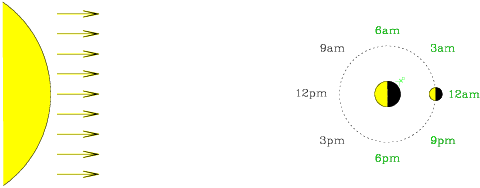 |
Wherever the Moon lies in the sky, it will always be visible from the half of
the Earth pointing toward it and hidden from sight from the half of the Earth
pointing away from it.
Recall that our figure shows us looking down on the Earth and Moon from above
the north pole; the Earth rotates once counterclockwise in place each day. We
can thus use the fact that noon is defined as the time at which the Sun is
highest in the sky, and midnight as the time when the Sun is most hidden, to
place a 24 hour clock dial on top of the Earth.
We label the times at which the Moon will be visible from Earth in green, from
the time at which it starts to rise above the horizon to the time at which it
starts to set below the horizon.
We can thus see that at 3am the Moon will lie well above the horizon (and by
6am it will be setting).


#3. If the waning gibbous Moon is rising on the eastern horizon, what time of the day or night is it?
| midnight (12am) | noon (12pm) |
| early morning (3am) | afternoon (3pm) |
| dawn (6am) | dusk (6pm) |
| morning (9am) | evening (9pm) |
The Moon is in the waning gibbous phase when it appears mostly illuminated
from Earth, in the days after a full Moon (with each passing night, a little
bit less of the Moon will be illuminated). It will be located on the opposite
side of the Earth from the Sun, coming out from behind the Earth and moving
around to the side.
When we are underneath this point we are on the side of the Earth hidden
(shadowed) from the Sun, so it must be nighttime. The waning gibbous Moon
will lie directly overhead when we have rotated an eighth of the way around
past midnight. This occurs three hours later, at 3am. The Moon will rise six
hours before it lies overhead. It thus rises six hours earlier, at 9pm.
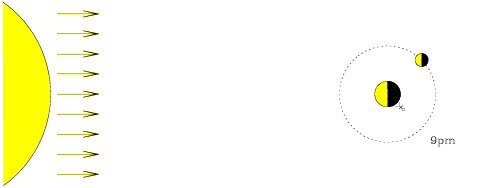 |


#4. If the Moon is currently in the waning gibbous phase, what phase will it have in seventeen to eighteen days (five-eighth of a lunar month) from now?
| full | new |
| waning gibbous | waxing crescent |
| third quarter | first quarter |
| waning crescent | waxing gibbous |
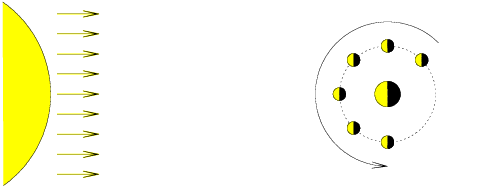 |


#5. If the waning crescent Moon rose nine hours ago, what time of the day or night is it?
| midnight (12am) | noon (12pm) |
| early morning (3am) | afternoon (3pm) |
| dawn (6am) | dusk (6pm) |
| morning (9am) | evening (9pm) |
The Moon is in the waning crescent phase when it appears partly illuminated
from Earth, in the days before a new Moon (with each passing night, a little
bit less of the Moon will be illuminated). It will be located on the same
side of the Earth as the Sun, moving around from the side to in front of the
Earth.
When we are underneath this point we are on the side of the Earth illuminated
by from the Sun, so it must be daytime. The waning crescent Moon will lie
directly overhead when we are rotated an eighth of the way around before noon.
This occurs three hours earlier, at 9am. The Moon will rise six hours before
it lies overhead. It thus rises six hours earlier, at 3am. If the Moon rose
nine hours ago, it is now noon.
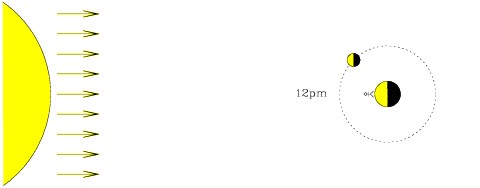 |

